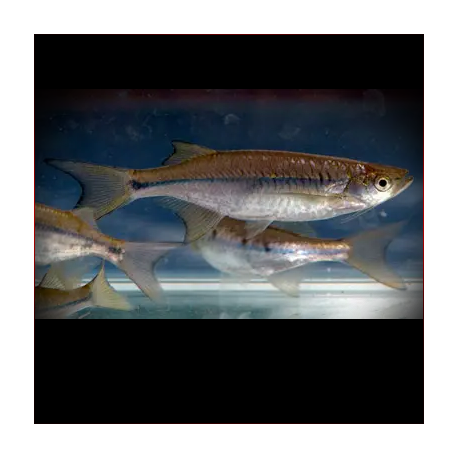More info
Datasheet
| Maximum Size | 10.5cm / 4.13inches |
General Description
Nematabramis alestes is a unique species within its genus, characterized by having shorter barbels compared to its head size. Additional distinguishing features include 8-9 branched dorsal-fin rays, 12-14 branched anal-fin rays, 22-23 predorsal scales, and a noticeable ventral keel along its body.
Aquarium Setup
When setting up an aquarium for Nematabramis alestes, it is essential to provide ample swimming space due to their active nature. A well-filtered tank with a combination of live plants and open swimming areas is ideal. Water parameters should mimic their natural habitat, with a temperature range of 22-28°C, pH level between 6.0-7.5, and moderate hardness. For specific details on tank size and compatible tank mates, refer to the table provided.
Behaviour
N. alestes are known for their lively and social behavior, often seen swimming actively throughout the tank. They thrive in shoals, displaying schooling behavior, which provides them with a sense of security. These danios are peaceful inhabitants but may exhibit some fin nipping, particularly if kept in insufficient numbers or in cramped conditions.
Feeding and Diet
In the wild, Nematabramis alestes are omnivores, feeding on a varied diet of small invertebrates, algae, and plant matter. In captivity, they readily accept high-quality flake or pellet food. Supplementing their diet with live or frozen foods like bloodworms, brine shrimp, and finely chopped vegetables will help maintain their health and vibrancy.
Reproduction & Dimorphism
Breeding N. alestes in captivity can be stimulated by providing them with a well-conditioned breeding tank containing fine-leaved plants for spawning. Males are typically slimmer and more colorful than females, especially during the breeding season. The eggs are adhesive and will attach to plants or tank decor. It is essential to remove the adults after spawning to prevent them from consuming the eggs.
Habitat and Distribution
Nematabramis alestes is native to the southern Philippines, specifically found in regions such as Basilan, Mindanao, Palawan, and Busuanga. While these are the primary locations, there may be populations on other nearby islands like Tawi-Tawi or Balabac. Their habitat ranges from fast-flowing tributary streams to stagnant pools, lakes, and even degraded swamps, showcasing their adaptability to various environments.

